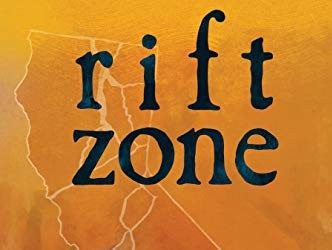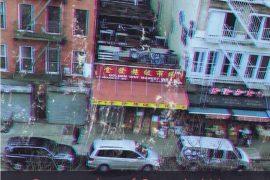“Whose fault // our fault” the poem “Three Dreams, 2018” opens. Tess Taylor’s fourth collection of poems, Rift Zone, tenders to her reader the language of fault, rift and fracture as her songs and aubades touch upon the geological, ecological and political of our lives.
Evoking California with poems set in Berkeley, Sacramento, and El Cerrito, Taylor carries her reader to place after place, from little hill, to quake, to peak. Sometimes the place is an event in time, as “Loma Prieta, 1989,” which features the earthquake of the same name that affected the San Francisco and Monterey Bay regions. In this poem, the speaker recounts:
We were girls
preparing for our concert
so even when the raw ground buckled
& bucked us up we went on singing
Later in the same poem, the speaker notes: “Even in the face // of devastation / we must make art,” and wonders that :
This was the lesson
Beth Avakian offered then
without a way of knowing
how much it would mean to me
these years later.
Rift Zone is a lyrically vulnerable collection, residing as much in memory as in the present times, as attentive to the sleeping infant and the partner ill with pneumonia as it is to sixth grade gun violence, white supremacist marches, and America’s mistreatment of immigrants—there is space, too, for the movements of tectonic plates and the backyard sequoia. In “Apocalypto W/ Aquaria,” the speaker marvels over the growing vocabulary of their child:
Bennet says tortuga. Each day
his bestiary grows.
Still everything we name is disappearing:
Zebra, hippopotamus, rhinoceros.
Soon I’ll also be explaining
how each word marks
a half-lost species:
O exotic & endangered letters.
To read Rift Zone is to be transported to someone else’s childhood, through someone else’s sense of place—from wherever you are as a reader, to the West Coast, to El Cerrito. Most of all, it is to feel the presences and the absences that the speaker feels in the land, the school that crumbled “in a landslide,” the bike path choked by blackberries (“Del Norte”)—that is, to feel the sense of place in Rift Zone convincingly. The nouns and geography of Rift Zone are lived, rich in the poet’s detailed attention, the language specific, rooted. Arguably, the best books take us someplace else—escape their reader from their own mind to the mind and the feelings of another person, another place and time. They open our world, such as the poem “Berkeley in the Nineties,” where the speaker recollects a decade in the first-person plural:
We were quick fish who read
Gary Snyder in someone’s dad’s Mendocino cabin.
Some of us climbed ferny gullies
on winter solstice & got topless.
………………………………
Reindeer lichen was the revolution.
Our new breasts in rain were revolutions.
We craved transcendental revelations,
the radical & burning future
The poem breaks off on an m-dash, as if to say—there was so much more. And in fact, the concept of abundance, and of the possibility of plenty, resides always at the edge of scarcity and disappearance in Taylor’s work. If only we could turn towards (and into) abundance, follow the “wise economy” of the California Redwoods, “Each ring…a living record; / a transitive, ongoing, / giant conjugate for being” (from “California Suites”). Nature models for us not only surviving, but thriving despite the many threats to being, and in the poem “Song with Pneumonia & Telemann,” the speaker recalls that “Redwoods can drink fog. / Their needles sip the numinous.” Inside the environment of the hospital, the speaker’s reflection borrows from the Redwoods in order to situate herself and name her relationship:
Now, another body carted in.
I perch on this electric bed.
Biotic, antibiotic: I am rocking.
I dream that I can be my husband’s fog:
I dream our lungs as cloud as tidal skein—
Another way the speaker is responsive to her environment is through her engagement with privilege and whiteness. Taylor is one of the poets I think of immediately, along with Joy Katz and Rachel Zucker, for their collective and individual attention to how white privilege and white supremacy inhabit and touch their lives. In her poem “Untitled with Sadness & Suckle,” Taylor’s speaker considers how, “Tonight’s emergency // is not emergent,” naming the emergency as “News that stays news but is not a poem. / Beating. Shooting. Children in cages.” In couplets with lines than break and detach, the speaker continues,
Sometimes I think that all
privilege is
is some safer vantage
for watching the trauma, America, happen.
Though Taylor names the pursuit of Rodney King by police and a memory of police violence (an abundant genre of harm in America), the trauma itself is “America”—an active event, rather than historical and past. It is Taylor’s specific, qualified attention that can balance nursing, police violence and immigrant abuse on the same, shared page, in the same adjacent lines. “We are animal / in the broken ecosystem,” she writes, the “we” extending its grammatical arm to gather her reader in. A quality of Taylor’s attention that any writer can learn from is how her poems do not settle for an easy or automatic word, but even the adjective describing the color of the light in her poems must be specific as a tint on a painter’s palette: “Same nectarine light,” the speaker wonders, living in both the nursing room and the memory of King’s television footage. Taylor’s work reminds her reader that the smallest word and pause matters for the white writer addressing white supremacist, police violence in America.

ii.
In Last West, Roadsongs for Dorothea Lange, published by The Museum of Modern Art (MOMA) in conjunction with the exhibition “Dorothea Lange: Words & Pictures,” Taylor’s reader again finds the poet in California, this time tracing the paths and archival artifacts of the American photography Dorothea Lange. Lange documented Californian migrant laborers, Dust Bowl refugees, tent cities, and Japanese internment camps during the Great Depression while working for the Farm Security Administration (FSA). Many of us know Lange’s work (if not her name) by her evocative photograph “Migrant Mother,” now known to be a photograph of an Indigenous Cherokee woman Florence Owens Thompson.
Last West works by collage and mixed-media, and Taylor draws on Dorothea Lange’s papers, notes, hand written captions, photographer’s travel reports, and an oral history interview with Richard K. Doud for the Archives of American Art. Made possibly by the archive, in Last West, Taylor gives new life to the archive through her retracing of Lange’s travels and the gathering of visual material (maps, Lange’s bulletin board, notes and photographs). Some of Taylor’s poems are letters to Dorothea Lange, communications from across nearly a hundred years of American life that reveal a deep kinship in the environmental and social states that Lange and Taylor witness and document. The first letter begins,
Dear Dorothea,
A cold & muddy spring—storms
& sudden freezes, like the year
you photographed migrant mother.
Wettest it’s been in years:
Rains heavy as drums, or
the cresting of a wave.
Flooded under every overpass.
*
Like the cresting of a wave,
the tents in cities now—
people shuffling belongings
out between the downpours.
*
or coughing in the alley
beside my daughter’s preschool.
Homeless, we say, but mean unhoused,
unsheltered also migrant
also escaping fleeing
or being moved along—
Oakland, Richmond, Berkeley:
underpasses ten tents deep.
Something I hope this review demonstrates is how Taylor’s work is simultaneously both lyric and reportage on the state of California. Her poetry reveals not so much a blending of the environmental and social, but that the two are inseparable and in direct relationship with each other. What bodies suffer the drought, the rains? Those in tents. Those sick. Those not planned for by the urban planners. Unlike so much newspaper reporting, Taylor’s language holds itself accountable at its adjectival level, and questions how we readily categorize and name our social ills as a means of dismissing them. “Homeless, we say, but mean unhoused, / unsheltered also migrant” Taylor writes in her letter to Lange, an artist and documenter who would have known exactly the people Taylor is talking about.
What can art do about the conditions the families of American migrant laborers and immigrants still face and live in, here and now? Lange’s work did more than silently document: it incited and engaged. One example: Lange informed the editor at a San Francisco newspaper about the conditions of a migrant labor camp, and sent him two of her photographs. Inspired by Lange, the editor ran an article, published Lange’s photographs, and informed the federal government who sent immediate aid. The fact is that the federal government can always send immediate aid, but that intervention depends upon the actions of documentation and outcry. Art can do this—your art can do this—today.
It is this awareness of art’s activism that Taylor brings to her own writing and to her engagement with Lange’s archive. Lange said: “The camera is an instrument that teaches people how to see without a camera,” and one might say of Taylor’s writing that it is poetry that teaches people how to pay attention without poetry.
One moving aspect of Lange’s notebook’s language that Taylor gathers and collages in Last West is the form of the list, and the way the list can spill a wide geography or agricultural bounty onto the page between the details of migrancy and labor. For example, the list “Crops”:
Lettuces
Melons
Carrots
Peas
Cantaloupe
Potatoes
Apricots
Peaches
Berries
Alfalfa
Beans
Cherries
Sugar beets
What looks like an entire Whole Foods produce section demonstrates a vast amount of labor, resources (water, soil, fertilizer), and good weather. No one area supports that incredible variety of crops without a great system of human labor in place, not to mention the pressure put on the environment to sustain it. Wittgenstein famously wrote that the meaning of a word is its use in the language—here, the meaning of a list is its use as a mini-catalog, evidence of consolidated wealth and the exploitation of human labor within the context of Lange’s life of documentary art.
Documentary art asks us to look again at the world we pass by each day, our attention elsewhere. Taylor’s tracing of Lange’s journey—and her letters to Lange—live and breathe because Taylor translates the concerns of Lange’s work into our present, incorporating the industrialized presence of border security and border patrol guards (“May: 78-East / Imperial”), men and women’s shelters, the homeless and “unhoused,” oral histories of immigrants and citizens, and more.
A remembrance and celebration of Dorothea Lange’s life and work, Taylor’s Last West is an awakening call to us as readers to “[think] again about the body / how to house the fragile human / in labor / dreams & rest.”
1. For more about Dorothea Lange, watch the PBS documentary film, Dorothea Lange: Grab a Hunk of Lightning (2014).





